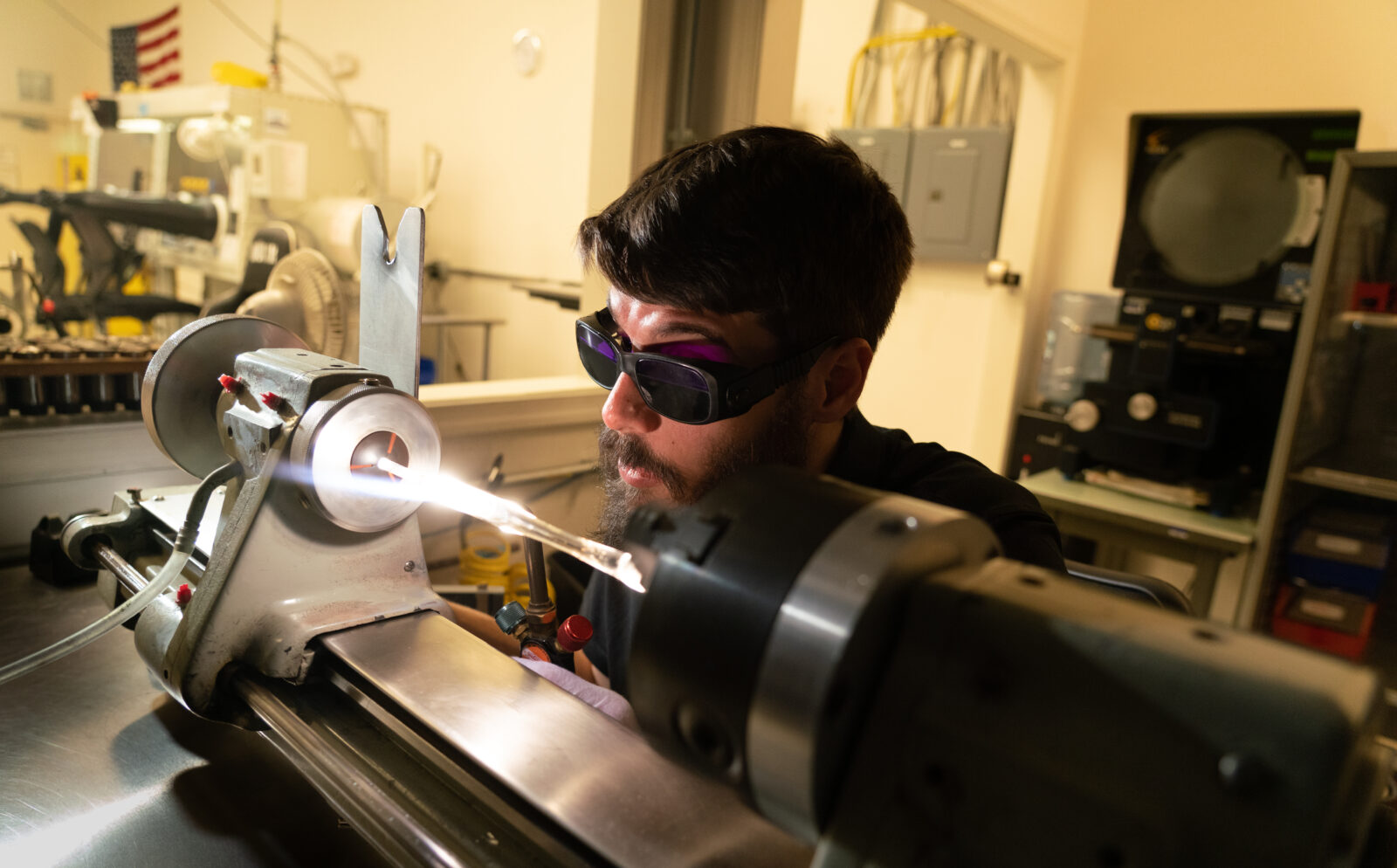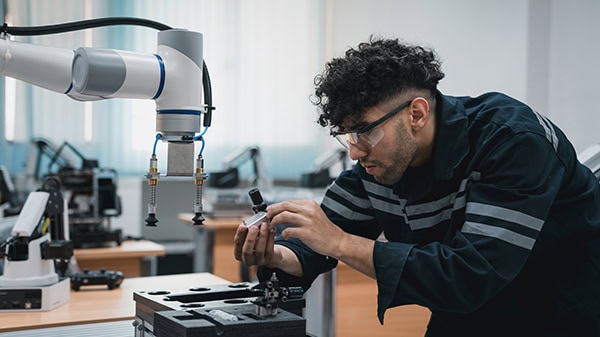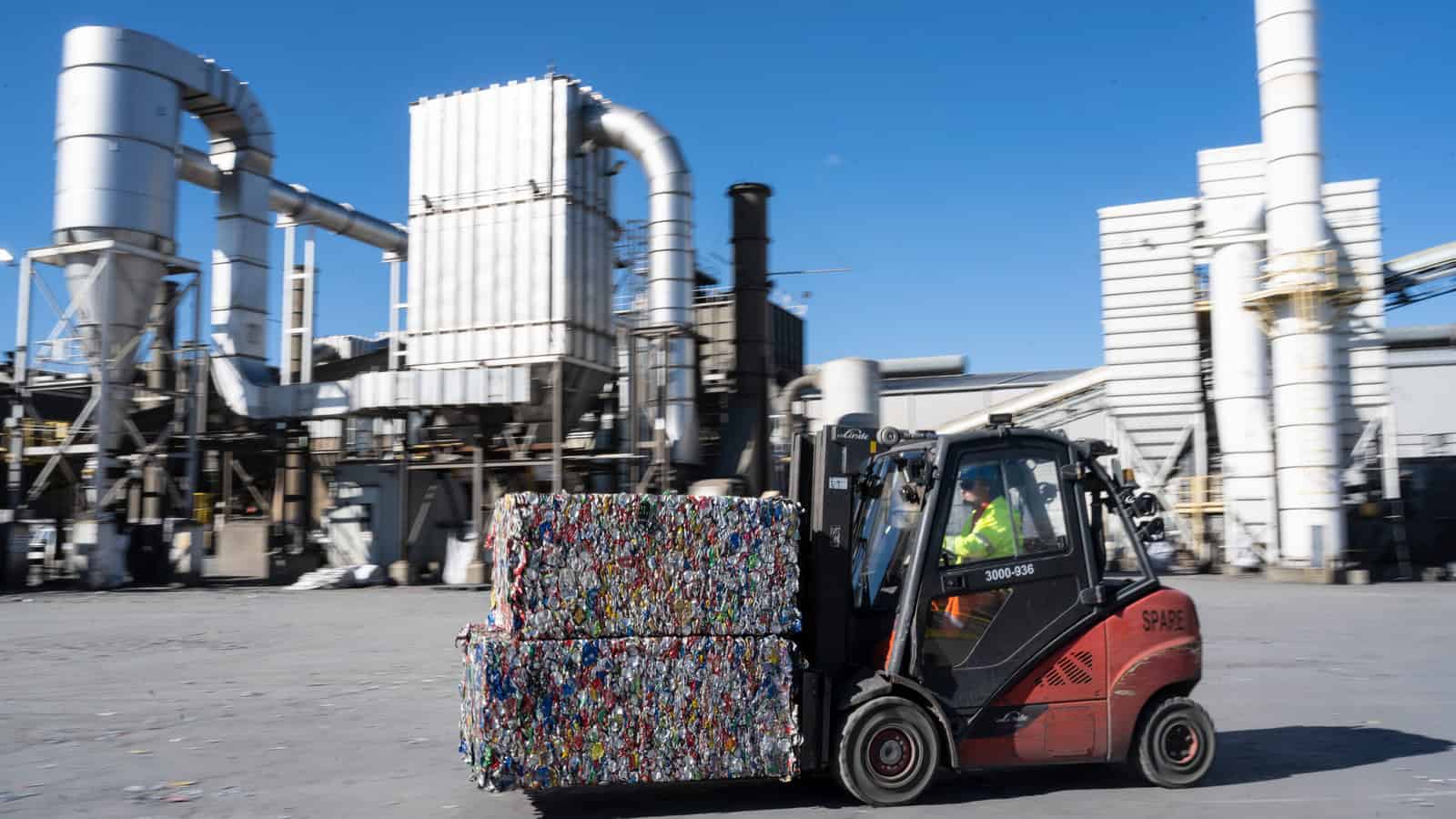Digital Transformation Sees Explosive Growth

Manufacturers are increasing their investments in digital assets, according to a recent survey from the Manufacturing Leadership Council, the NAM’s digital transformation division.
What’s going on: Due in large part to expectations of economic growth, manufacturers plan to either maintain or boost their spending on smart factory investments, they told the MLC in the recently published results of the Smart Factories and Digital Production Survey.
- Respondents also said they are optimistic about continued digitization and adoption, with 69% expecting moderate growth and no recession.
- While 28% would call their current operations “smart” or “somewhat smart,” 76% expect to be there in the next two years.
- Awareness of AI is growing by leaps and bounds among manufacturers; some 34% said they see AI as very significant. (Last year, just 10% said the same.)
Key points: The survey’s top takeaways include the following:
- Digital transformation is changing the game: Most manufacturers—60%—see digital transformation as something that is redefining the industry.
- More manufacturers are going digital: Some 75% of manufacturers say they are at “midlevel” digital maturity, up significantly from 2024 and 2023.
- AI’s role is inevitable: Fully 80% of manufacturers fully or partially agree self-managing and self-learning facilities powered by AI and machine learning are coming.
How a Small Manufacturer Offers Big Retirement Benefits

401(k) fees are a hot topic of conversation if you are an HR leader. When Miltec UV Human Resources Director Karen McKernan was discussing 401(k)s with an old friend, she discovered that Miltec, a small manufacturer, paid much more in fees than her friend’s larger employer. She was aghast, but what could Miltec do about it? The company did not have the purchasing power of a large firm, and so its options seemed limited.
Not so fast. Soon after that conversation, McKernan started receiving emails from the NAM about its new multiple employer plan, the Manufacturers Retirement & 401(k) Savings Plan, which allows many companies to participate in one 401(k) plan. Not only does the larger number of participants lower the fees, but the plan offers administrative and compliance oversight, as well as other benefits.
After doing her research, McKernan was convinced. By mid-2022, she was working with the NAM, the plan administrator, and recordkeeper and service provider Principal to make the switch. On Nov. 1, 2022, the new plan went live for Miltec employees. Today, McKernan says, she would never go back.
The benefits: Once McKernan laid out all the advantages for Miltec’s owners and 401(k) trustees, NAM 401(k) was an “easy sell,” she told us.
- Not only did the fee reduction seem like a “no-brainer,” but the new plan would lift a considerable administrative burden that had fallen entirely on McKernan. It would also offer benefits to employees that Miltec, as a small company, could not add on its own without creating even more administrative tasks.
- Furthermore, the NAM 401(k) comes with an independent 3 (38) investment fiduciary, One Digital, which reviews the funds’ performance regularly and issues reports on a quarterly basis, ensuring low-performing funds are “watched” and subsequently removed and replaced when needed. By delegating investment decisions under this arrangement, a company significantly reduces its potential liability for poor investment decisions.
- Additionally, any plan with more than 100 participants must undergo an annual audit, which is time consuming and expensive. Under NAM 401(k), the plan coordinates and manages the audit for participating companies.
What she doesn’t miss: McKernan listed all the duties she used to perform for Miltec’s own 401(k), which have now been taken over entirely by the NAM’s plan. She doesn’t miss:
- Monitoring enrollment, which Miltec’s employees can now undertake directly on Principal’s website;
- Sending out many required annual notices;
- Compliance testing and 5500 filings (which ensures the plan meets the IRS’s requirements for retirement plans, so that employees can receive tax benefits);
- Sending out summary annual financial reports and quarterly statements; and
- Handling employees’ questions and all communications about the plan.
In contrast, McKernan now only provides information to Principal through an automated payroll report and keeps an eye on how things are going, just in case. There have been few problems, she told us, and those were fixed with alacrity by Principal and the NAM.
Implementation: The entire timeline, from learning about NAM 401(k) to finalizing the switchover, took no more than a few months, McKernan said.
- Principal oversaw the transition, with weekly check-ins, a dedicated project manager and a schedule that included clear deadlines. While transitioning 401(k) plans is “a project,” McKernan said, Principal “managed it very well, including all required communications, and finishing right on time.”
- A word of advice: “If I had to do it all over again, I would have moved the plan over on Jan. 1 instead of Nov. 1,” said McKernan. Having two different plans in one year proved to be more of a headache than she expected, as it forced Miltec to do compliance testing on both plans in 2022.
The reception: “The company’s employees and owners are very pleased with the new NAM plan,” McKernan said.
- Aside from the savings in time and money, NAM 401(k) offers a host of other features that manufacturers can customize. One new feature that has proved popular with Miltec’s employees is loans, noted McKernan.
- In addition, Miltec’s previous plan had a 12-month waiting period before employees could participate, but NAM 401(k) reduced the wait to six months—which is far more appealing to new hires, she added.
- Ultimately, Miltec’s leaders and employees understood and appreciated the logic of joining a multiple employer plan, said McKernan. “They recognize the more participants you have, the more buying power you have. They are seeing the positive results of having access to a robust fund lineup and how that translates to lower fees every time they receive a quarterly statement.”
The bottom line: “I honestly don’t see how a small manufacturing company wouldn’t benefit from joining the NAM 401(k),” said McKernan.
- “I’ve been in HR for a very long time, and when we talk to job candidates about benefits, the 401(k) plan always comes up. It’s a benefit that is necessary to attract talent, as well as help your employees meet their retirement goals,” she added.
- “I wouldn’t hesitate to recommend this plan to any small, medium or large manufacturer.”
Rethink 2025 Is Coming Up Fast

Get ready! Manufacturing’s leading annual event on accelerating digital transformation is right around the corner.
What’s going on: Rethink—held by the Manufacturing Leadership Council on Marco Island, Florida, each June—is a must-attend conference for anyone interested in Manufacturing 4.0 and where it’s headed (The MLC is the digital transformation division of the NAM.)
- This year’s event takes place June 15–18 at the JW Marriott Marco Island Beach Resort.
Why you should go: Rethink attendees will get an inside look at the cutting-edge processes and technologies transforming manufacturing today—directly from those creating and implementing them. They’ll also get a chance to:
- Consult with peers on manufacturing’s most critical initiatives, including smart factories and digital production, resilient supply networks and analytics and data mastery;
- Participate in real-time discussions and one-on-one meetings to help them understand how various solutions can solve their business problems;
- Hear from industry leaders and experts during panel discussions, executive interviews and more;
- Interact and collaborate with peers during interactive “think tank” sessions; and
- Hear from the MLC’s event partners during Rethink’s exclusive VIP Tour.
Who will be there: Scheduled speakers include Siemens USA President and CEO Barbara Humpton, Eaton Vice President of Industry 4.0 Craig Sutton, Hershey Company Vice President of Manufacturing, Operations Technology and Supply Chain Strategy Will Bonifant, Rockwell Automation Senior Vice President of Intelligent Devices Tessa Myers and many more.
The gala: Closing out the packed three-day event is the Manufacturing Leadership Awards Gala, at which the MLC will recognize award finalists and winners of the Future of Manufacturing Award, the Manufacturing Leader of the Year, the Small/Medium Enterprise Manufacturer of the Year and the Large Enterprise Manufacturer of the Year. The gala will take place on the evening of June 18.
Attend: Register online here for Rethink 2025. (NAM members get a discount at checkout.) Questions? Send them to [email protected].
Ford Gives Breast Cancer Patients a Comfortable Ride

After several grueling rounds of chemo, Lynn Simoncini found herself preparing for a mastectomy in November 2022. She searched for advice on online forums for breast cancer patients and came across a warning that surprised her—a major challenge for patients following surgery was the simple act of wearing a seatbelt.
When Simoncini was recovering from her own operation, she found this warning was correct. it was impossible to drive comfortably with a seatbelt pressing painfully against the surgical scar. She tried wrapping the belt in a hand towel, but it didn’t work very well; other patients also came up with makeshift solutions, but some just drove unsafely while holding their seatbelts away from their chests.
Unlike other patients, however, Simoncini was well-placed to find a solution. A creative director at VML who works on the Ford Motor Company account, she sketched out a design for a seat belt attachment that could be manufactured by the automaker. With the help of her writing partner and manager, she pitched the idea to Ford. The result: Ford’s recently released SupportBelt, now available to patients nationwide—for free.
Company account, she sketched out a design for a seat belt attachment that could be manufactured by the automaker. With the help of her writing partner and manager, she pitched the idea to Ford. The result: Ford’s recently released SupportBelt, now available to patients nationwide—for free.
Ford takes it on: Ford, which has a 30-year history of supporting breast cancer patients through its Warriors in Pink program, was incredibly receptive to Simoncini’s idea, she told us. The company gave her design to engineer Emily Obert, Ford’s manager of in-vehicle accessibility in digital product design, who began developing prototypes.
The process: As Obert worked on the project with Simoncini’s help, they discovered that the need for this belt was considerable. First, oncologists told them that the inability to wear seatbelts was widespread among patients, which Ford had not known previously, Obert said.
- The patients that Obert interviewed also said that their chests were sensitive even during chemo and before surgery, and many still had some chest discomfort long after the operation. In addition, chemo ports are installed in the upper chest and can often make wearing a seatbelt uncomfortable.
- With 100,000 women undergoing mastectomies every year in the U.S., and many more undergoing other stages of treatment, the SupportBelt would be hugely helpful, Obert realized.
The innovation: The winning design is elegantly simple. A soft foam pad, hollow on the inside, rests against the chest underneath the seatbelt, which is secured to it by Velcro straps.
seatbelt, which is secured to it by Velcro straps.
- The SupportBelt’s hollow pad gives it the flexibility to conform to different body shapes, and the soft foam alleviates the pressure on the sensitive area, Obert explained.
- The belt is slightly longer than a typical seatbelt attachment, which keeps its ends further away from the chest. It is also designed to cup the shoulder and reduce pressure on that area as well, which is also often sensitive following surgery.
- Lastly, the SupportBelt is crafted carefully so that the driver can move his or her head with ease and features leather accents that complement a car’s interior.
The launch: After the company completed testing, the SupportBelt was finally ready for production and distribution. This past October, patients began getting their belts—free of charge.
- Right now, the belts are only available to the U.S., and Ford is still fulfilling its first 2,500 orders. It has more belts available, however, and is gearing up for a next round of orders.
Attention, automakers: Ford has made the SupportBelt design open source, in the hopes that other automakers will make their own versions to blend in with their cars’ materials. “That’s my dream,” said Simoncini.
The last words: Simoncini is glad that her teenage son got to witness the development of the SupportBelt, which became a source of inspiration and pride during a painful time in their lives. She says that the whole experience makes her especially proud to work with Ford, a company that “walks the walk.”
- “This got me to work every day” during her illness, she told us.
Read more, order here: If you want to learn more about the SupportBelt or order one, please go here.
Trend of the Week: Enabling Innovation in Manufacturing

At the NAM, we’re examining some of the top trends that are shaping manufacturing this year, and offering the resources you need to take action.
Today, we’re taking a look at the industry’s efforts to enable innovation—and how manufacturers are working to stay on the cutting edge.
Applying technology: Digitalization can increase the speed and agility of innovations in areas like prototyping, iteration, simulation and modeling. And by using AI and data analytics to improve decision-making, manufacturers can build resilient, transparent supply chains that are more efficient and effective.
Upscaling workforces: Because of the rapid pace of technological advancement and adoption, manufacturers will have to create a workforce that is ready for the future—and processes designed to transfer knowledge and skills effectively and continuously.
Harnessing partnerships: Manufacturers can lean into collaborations that help to accelerate innovation. By connecting with manufacturing peers, government institutions and academia, industry leaders can develop unique and inventive paths forward.
Expert insight: According to CEO and Co-Founder of Narratize Katie Trauth Taylor, tools like generative artificial intelligence can accelerate and automate manufacturing innovation—with human ingenuity at the helm.
- “Human-led AI methodologies enhance teams’ ability to analyze opportunities, translate complex concepts into compelling business cases and think deeply about their innovative work,” said Taylor. “With reduced documentation and improved communications, product teams can reallocate their time value-generating work—deeper market research, sharper strategy and accelerated development.”
Resources for you: Want to dive deeper? Check out some additional resources from the NAM.
- Explore the Innovation Research Interchange, a division of the NAM that focuses on value creation and top-line growth through the management of innovation.
- Join one of the Manufacturing Leadership Council’s Plant Tours in person—or read summaries of past tours—to get an inside look at how other manufacturers have reshaped processes to advance their businesses.
Siemens Does More with Less

When Siemens sees a feasible way to save resources and improve efficiency, the company takes it.
Case in point: The global industrial manufacturing and technology business recently opened one of the first all-electric powder coating paint lines for the electrical distribution industry in the U.S., in Grand Prairie, Texas, to cut down on natural gas consumption.
- Siemens wholly replaced the original paint line to an all-electric system, which has reduced natural gas consumption by more than 90%, according to the company.
- “The timing was fortuitous,” said Stacy Mahler, U.S. head of sustainability for Siemens Smart Infrastructure. “We’d done an assessment of [the facility] and saw that our Scope 1 emissions were coming mostly from the paint line, which at 30 years old was due for replacement. The team realized that there was an opportunity to make an investment that would not only modernize the process but also lower the carbon footprint and help to manage the volatility in energy cost.”
- That change—made without interruption to plant operations because the new line was built alongside the old line—is part of Siemens’ larger goal to achieve a net-zero carbon footprint across its operations by 2030. It’s 55% of the way there already.
- Next up: assessing other company facilities globally for the same all-electric upgrade. One outcome of the effort in Grand Prairie is a cross-business team of experts working to replicate success at Siemens’ other facilities, like the newly expanded facility in Pomona, California, while sharing their knowledge with the broader manufacturing community.
Waste not: At its Spartanburg, South Carolina, site, Siemens is extracting and reusing waste oil found in materials on the floor.
- “We’ve partnered with a third-party company that provides the infrastructure within our own facility to take oil from rags and other materials, absorb it and then recycle or downcycle it,” Mahler told the NAM, adding that in the latter, the oil can be made available for other downstream applications.
- The impact is big, recycling about “3,000 pounds of oil-absorbent material that otherwise would have gone to landfill.”
From trash to energy: Siemens has also designated two of its American facilities—the one in Grand Prairie and another in Hingham, Massachusetts—as “landfill-free,” meaning that the sites incinerate all their nonrecyclable waste, producing thermal energy to power operations.
- “We’re taking waste that’s coming out of the facility, and instead of having waste management take it, we partner with a company that extends the useful life of the raw material and prevents it from sitting in a landfill,” Mahler said.
- The two-facility program redirects approximately 1,000 tons of waste each year.
Reusing metals: At its Roebuck, South Carolina, manufacturing center, Siemens uses a wastewater treatment process that recovers metals for reuse.
- The onsite system “extracts valuable metals—including copper, aluminum, tin and iron—from sludge that are a byproduct of painting and fabrication processes,” Mahler said. “These are then recycled instead of sent to the landfill.”
- Siemens recovers about 59,000 pounds of metal annually this way.
Even the windows: Siemens has also slashed energy consumption at its Fort Worth, Texas, facility using a unique type of window.
- Michigan-based glass solutions startup LuxWall recently installed its Enthermal Glass windows throughout the office in the Siemens plant. “The glass operates like a thermos, reducing both emissions and the energy bill,” according to Mahler.
- Installing the windows can cut a building’s emissions by 35% to 40% and reduce cooling costs by 20%, according to LuxWall.
- Siemens has been so impressed with the reductions it’s seen that it has even begun “sharing the product with our suppliers and customers.”
Onward and upward: Chief among Siemens’ sustainability goals for the coming years is “accelerating action across our other U.S. facilities, our supply chain and for the manufacturing sector as a whole,” said Mahler.
- “We’re trying to pave the way, show proof of concept and hopefully remove some of the barriers in the name of sustainability and more efficient operations.”
Why Constellium Recycles Cans—and You Should, Too

If you’re finished with that soda, Constellium hopes you’ll throw the can in the nearest recycling bin.
Use and reuse: Used cans are the mainstay of the global aluminum manufacturer and recycling giant, which owns and operates one of the world’s largest used beverage can (UBC) plants, in Muscle Shoals, Alabama. There the company recycles the equivalent of more than 20 billion cans every year.
- “We shred the cans, remove the inks and coatings and then remelt that into aluminum we can use,” said Constellium Vice President of Strategy and Business Planning for Packaging and Automotive Rolled Products Raphael Thevenin. “It’s a very circular way of using the material. Within 60 days, it’s back on the shelf” as new cans.
- Using UBCs to make new cans consumes 95% less energy than using new aluminum and is a key piece of the entire aluminum production supply chain.
Many uses: Aluminum can be recycled almost infinitely, a characteristic that gives the metal a wide variety of applications in manufacturing, as does its light weight and durability.
- In addition to canstock, Constellium’s aluminum products include auto rolled and structural products used for vehicle hoods, doors, battery enclosures and bumpers, as well as aerospace solutions, armored products for the defense industry and much more.
Why cans? UBCs are “so widely available in the U.S., and we have such a strong network of traders that we’re able to recycle them in large volumes,” Thevenin continued, adding that 10 American states give cash deposits on beverage containers. (This means that consumers can redeem their empties for cash, currently an average of 5 cents a pounds for aluminum cans.)
- However, while the U.S. consumer recycling rate for UBCs is generally higher in states with deposits, it’s on the decline nationwide, having fallen to 43% in 2023 from 45% in 2020.
- “We’re seeing a million tons of aluminum landfilled in the U.S. every year,” according to Thevenin.
What they’re doing: The increasing number of UBCs consigned to the trash means “the availability of scrap metal is declining,” Thevenin continued.
- In an effort to reverse the trend, Constellium is assessing the possibility of pushing for greater collection efforts in areas where UBC recycling is low, urging states with deposits to offer more money for exchanges and advocating the construction of more UBC-recycling infrastructure throughout the U.S.
Why it’s important: For the sake of both cost and sustainability, the U.S. must increase its stock of available aluminum scrap, Thevenin said.
- “Because we don’t have the [widespread] infrastructure in place, a lot of scrap is exported outside the U.S.,” he told us. “But if we want to make sure the products we put on the market are sustainable and profitable, we have to use as much recycled material as possible.”
- Europe recycles about 75% of its UBCs and is set to recycle about 90% by the end of the decade, according to Thevenin. “There’s a huge need to reduce the gap between the U.S. and Europe.”
- To that end, Constellium has undertaken a campaign to educate lawmakers on the need to build out U.S. infrastructure. “We need to make sure legislators are aware,” said Thevenin. “They need to understand the importance of keeping more scrap metal at home.”
Recycling cars: In Europe and North America, Constellium is actively investigating new ways to recycle aluminum from old cars efficiently, either through sorting or dismantling.
- “It’s about a 10-to-15-year cycle for car recycling, meaning that the metal comes back in the form of a new car all those years after” the initial recycling, Thevenin said. “Today the most economical way to get scrap from a car is to shred it, so you get a mix of materials and have to sort plastics, glass, metals, then nonferrous metals and steel. We’re working on developing new alloys that are more scrap tolerant and testing them on the market.”
- Constellium is also collaborating with manufacturers on creating a laser/X-ray machine that will be able to sort the different alloys in recycled cars, easing and speeding the recycling process.
- In the longer term, the company hopes to work with automotive makers to standardize the alloys used in vehicles because “when it’s mixed, it’s more difficult to sort.”
The bottom line: Aluminum recycling is a no-brainer because it’s a win for consumers, manufacturers, retailers and the environment, Thevenin went on.
- For example, once a UBC collection plant “is operational, it’s self-sustaining because [the operator] can sell to companies, such as Constellium, and then invest that revenue on more and better infrastructure.”
- When it comes to vehicles, “when car makers develop a new model, they should make sure it’s easy to recycle” because doing so will mean both cost savings and “being able to offer consumers lower-carbon products.”
Former TSA Communications Lead Joins the NAM

Former Transportation Security Administration Assistant Administrator for Strategic Communications and Public Affairs Alexa Lopez has joined the NAM’s communications team.
What’s going on: Lopez, a native of Dayton, Ohio, is the NAM’s vice president of communications and public affairs, a newly created position.
- “Alexa knows how to navigate complex challenges, craft compelling narratives and drive real impact,” NAM President and CEO Jay Timmons said. “She has built a career on delivering results, and manufacturers will benefit from her ability to elevate our industry’s voice at a time when manufacturers’ influence on the future has never been more important.”
- Lopez holds a Master of Public Affairs and a Master of Arts in Arts Administration from the Indiana University O’Neill School of Public and Environmental Affairs.
Proven track record: At the TSA, Lopez led all media operations, strategic communications, marketing and branding and multimedia efforts and served as adviser to the TSA administrator. She was at the agency for four years.
- Prior to that, Lopez worked in public affairs at the Federal Emergency Management Agency, the American Society of Civil Engineers, Ogilvy Public Relations and the City of Bloomington, Indiana.
Milo’s Tea Has a Recipe for Sustainability

At Milo’s Tea, every element of the company’s delicious beverages is scrutinized for sustainability opportunities—from bottle-sourcing to the water and tea leaves that go into each gallon.
The bottles: The Bessemer, Alabama–based business recently opened a new, one-gallon bottle-blowing facility in its hometown, right next to its distribution center.
- The new facility will reduce carbon dioxide emissions by 1,000 metric tons per year, since it will eliminate the need for trucks to travel from farther-off bottling locations to the Bessemer distribution facility.
- “We’re still family-held, and sustainability is a family value, too,” said Chief Operating Officer Chris Droney. “When you have a project like this, that has a positive environmental impact and allows us to reinvest in our company growth, that’s a win–win.”
The water: The 78-year-old Milo’s Tea—which in 2022 became the top-selling refrigerated tea brand in the U.S. and is the fastest-growing refrigerated lemonade brand—has a strong track record of environmental resource preservation, starting with its water conservation.
- Since 2019, Milo’s has conserved nearly 37 million gallons of water, an achievement that has helped earn the certified woman-owned business two Platinum TRUE Zero Waste certifications (one for its Bessemer plant and another for its Tulsa, Oklahoma, facility).
- Among other measures, the company has invested in new, more water-efficient line-cleaning (clean-in-place) technology, which it uses between production runs to clean the brew, blend and filler equipment. “If we’re going from making sweet tea to zero-calorie tea, for example, it’s very important to make sure there’s no residue” in the lines, Droney explained.
- The enhanced equipment reduces energy, water and cleaning agent consumption, while also improving the effectiveness of the cleaning cycle. Milo’s made additional improvements to the production scheduling process, which decreased the total number of cleaning cycles required and further reduced energy, water and cleaning agent consumption.
- Milo’s was also able to reduce the amount of excess product the company had in its tanks during those flavor switchovers, further reducing waste and water use.
The tea: Milo’s earned its Oklahoma Zero Waste certification in part through “re-earthing” its tea leaves—“the largest waste stream we have”—in partnership with GEM Dirt, Droney said.
- The topsoil company takes Milo’s spent tea leaves and turns them into compost that it blends with dirt to create nutrient-rich soils. In 2023, Milo’s re-earthed more than 10,000 tons of used tea leaves from all facilities.
The packaging: When it comes to packaging, Milo’s doesn’t let dents stand in its way. The firm has installed compressed air stations on its lines to un-dent damaged bottles before they’re filled, so that none are thrown away.
- “At our flagship facility in Bessemer, if bottles can’t be undented, we send them back to the manufacturer and they can be reground and made into new bottles,” Droney continued. “A recycled bottle uses less resin than a new one.”
The production process: Milo’s has also recycled and diverted more than 148,000 tons of waste since 2019, another reason it has been so highly certified. On top of that, it has prioritized renewable energy sources at its facilities.
- Solar panels went live at the Bessemer plant in 2023, and this past summer, the business commissioned a rooftop solar farm at its Tulsa facility.
- The panels offset from 5% to 10% of each site’s total annual energy consumption, Droney told us. More solar panels are scheduled for other Milo’s sites, he added.
Advice for other manufacturers: Careful environmental stewardship can pay dividends for manufacturers, according to Droney.
- Profitability and sustainability “go hand in hand; we really believe that,” he said. “Solar power, onsite bottle blowing—there’s a cost to it, but there’s also a benefit. When you combine those, not only are you doing the right thing, but you’re generating fuel for future growth. We all have a responsibility to drive sustainability.”
Hyzon Reimagines Transportation

If you ask the leaders at Hyzon what kind of company it is, the answer might surprise you. The business, which manufactures “high-performance hydrogen fuel cell systems,” doesn’t consider itself just a manufacturer.
Making things possible: “We are a clean technology company that makes it possible to provide emissions-free power to some of the most difficult applications out there,” said Chief Operating Officer Dr. Bappaditya Banerjee. “It just so happens we are starting with Class 8 and refuse trucks.”
- In September, the Bolingbrook, Illinois–based firm announced the start of production of its single-stack, 200-kilowatt fuel cell systems to power those heavy-duty hydrogen fuel cell trucks. Hyzon is the only U.S. producer of the single-stack 200-kilowatt fuel cell.
- The new system is an upgrade from the 110-kilowatt fuel cell assemblies that Hyzon used in its first-generation vehicles.
- “If we were to put together two 110-kilowatt fuel cells to get to 200 kilowatts, the single-stack system would be 30% lighter than two110-kilowatt systems, as well as 25% cheaper to produce,” Banerjee said.
A differentiator: The company aimed to scale up the power of the engine without also significantly scaling up the size—no easy task. So Hyzon developed a proprietary solution: its hybrid bi-polar plate technology.
- “Most [fuel cell] stacks are either metal or carbon, but ours are hybrid,” Banerjee explained. “By hybrid, we mean that the cathode—where the oxygen comes into the system—is carbon, while the anode side is metal. The carbon side is more corrosion resistant while the metal side is strong, rigid and easier to manufacture, which allows a compact design.”
- “It’s the structure of the plates and the unique 200-kilowatt, single-stack design that allowed us to make it small enough to fit under the hood of a truck,” added Hyzon Vice President of Global Engineering Ravi Desai. “What does this is the design combination of our Membrane Electrode Assembly, the bi-polar plates and the compact balance of plant,” he said, referring to the network of pipes, hoses and fittings necessary for the fuel cell stack to work.
Uses and range: Hyzon offers two different emissions-free, heavy-duty vehicle types for industrial and commercial use, including a refuse collection truck. The models boast driving ranges comparable to those of diesel-powered trucks.
- The Heavy Duty Class 8 Fuel Cell trucks can typically go 350 miles from full storage tanks to empty, while the Fuel Cell garbage trucks can do a full day of work (at least 1,200 trash bin lifts and 125 miles of driving range) on a full tank.
- The trucks take about 15 to 20 minutes to refuel with a fast-fill dispenser at 350 bar, the pressure of the hydrogen gas needed to fill the trucks.
A challenge: In the U.S., the only publicly available hydrogen fuel refilling stations are in California, restricting widespread adoption for now. Meanwhile, the cost of filling up can be high.
- To support the construction of stations around the country and lower prices, the Biden administration announced $7 billion in funding last year for regional clean hydrogen “hubs.”
- In addition, the Inflation Reduction Act created the 45V hydrogen production tax credit, designed to help jumpstart scalable and sustainable domestic hydrogen fuel production.
- The credit is not yet available to companies, however, as the administration works to issue final regulatory guidance. The NAM has worked tirelessly to ensure this guidance is as broad, flexible and fair as possible.
Good for everyone: Hyzon doesn’t want to be the only player in the hydrogen ecosystem. On the contrary, it welcomes competition for the good of consumers and the industry.
- “The number of people who have been able to provide something useful [in transportation] using hydrogen is so limited that the more of us who succeed, the more it allows for hydrogen to become a normal part of our infrastructure,” said Banerjee. “A rising tide lifts all boats.”
